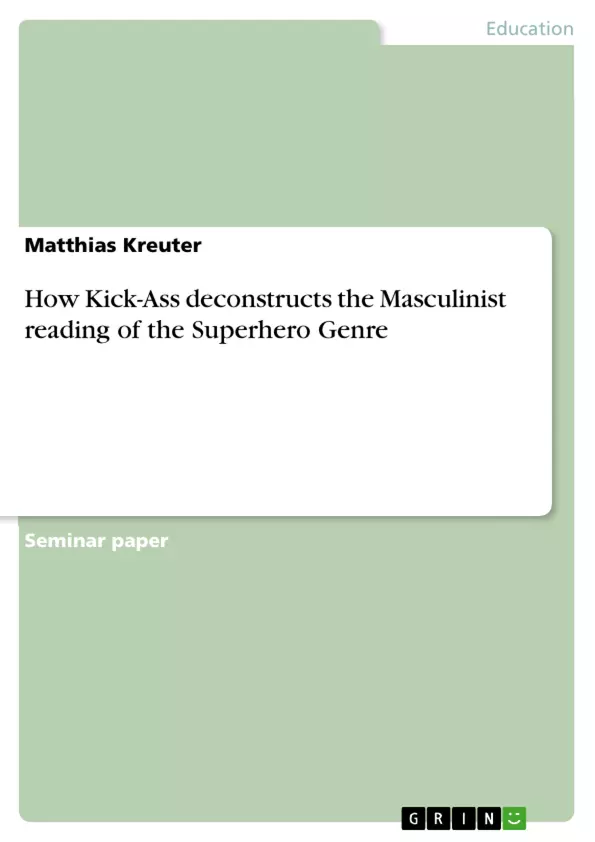Roughly 80 years after Superman’s invention in 1938 as "the ultimate power fantasy” for American men whose virility struggled under the socio-economic situation his, role still indicates the idealization of the strong, potent male. The recent reinstallment of Superman's cinematic career in "Men of Steel" (2013) supports what numerous scholars agree upon: To this day, superhero stories most often depict characters who typify conventional gender norms, with the traditionally male heroes denoting a masculinist structure. In times of changing gender norms and a steeply increasing interest in superhero stories, the unchanged masculinist structure in contemporary genre representatives becomes more apparent than ever.
This paper examines how the subversive agenda of the superhero story Kick-Ass unmasks the masculinist nature of the very characteristics that define the superhero genre and how Kick-Ass deconstructs them by offering self-aware alternatives.
Inhaltsverzeichnis (Table of Contents)
- Introduction
- Conceptual overview
- Judith Butler's cornerstones of gender studies
- A masculinist reading of the superhero genre
- The origin story
- Dual identities
- The role as protector and savior
- First conclusions and an updated research premise
- Analyzing Kick-Ass
- Kick-Ass' metafictive origin story
- Differentiating dual identities, gender performance and hypermasculinity
- Deconstructing the status of the patriarchal protector
- Kick-Ass' mission and the narrative ending
- Significant differences between the comics and films
- Conclusion
Zielsetzung und Themenschwerpunkte (Objectives and Key Themes)
This paper investigates how the subversive agenda of the superhero story Kick-Ass unmasks the masculinist nature of the very characteristics that define the superhero genre and how Kick-Ass deconstructs them by offering self-aware alternatives. It explores the traditional masculinist framework of the superhero genre through the lens of Judith Butler's gender studies.
- Judith Butler's concept of gender as a social construct and the deconstruction of binary gender structures.
- The masculinist reading of superhero narratives, particularly focusing on the origin story, dual identities, and the role of the protector.
- Analysis of how Kick-Ass subverts traditional superhero tropes and presents alternative understandings of gender, masculinity, and heroism.
- Examination of how Kick-Ass deconstructs the idealized, hypermasculine superhero archetype.
- Comparison of the comic book and film adaptations of Kick-Ass to analyze the evolution of the narrative and its themes.
Zusammenfassung der Kapitel (Chapter Summaries)
- Introduction: The introduction contextualizes the study by highlighting the enduring presence of masculine ideals in superhero narratives, even in contemporary examples like Man of Steel. It proposes an examination of how Kick-Ass subverts these traditional norms.
- Conceptual overview: This chapter lays out the theoretical framework for the analysis. It introduces Judith Butler's key concepts of gender as a construct, the performance of gender, and hypermasculinity, providing a foundation for understanding the masculinist tendencies in the superhero genre.
- Analyzing Kick-Ass: This chapter examines the specific case of Kick-Ass, delving into its unique origin story, its subversion of traditional superhero tropes, and its portrayal of dual identities, hypermasculinity, and the role of the protector. It explores the differences between the comic book and film adaptations of Kick-Ass, highlighting the evolution of the narrative and its thematic implications.
Schlüsselwörter (Keywords)
This paper examines key terms and concepts such as gender studies, Judith Butler, gender performance, hypermasculinity, superhero genre, origin story, dual identity, protector, savior, subversion, deconstruction, Kick-Ass, comic books, film adaptation.
- Arbeit zitieren
- Matthias Kreuter (Autor:in), 2016, How Kick-Ass deconstructs the Masculinist reading of the Superhero Genre, München, GRIN Verlag, https://www.grin.com/document/424276



